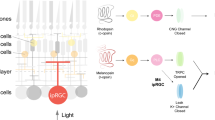Abstract
Both retinally degenerate and wildtype mice lengthened the period of their free-running circadian rhythms and reduced the amount of wheel running when exposed to increasing levels of constant illumination, in accordance with Aschoff's rule. Decreased locomotor activity may contribute toward lengthening of period in bright light. However, the known effects of activity on free-running period are small compared to those obtained by changing illumination. This suggests that Aschoff's rule in mice is not dependent on changes in nonphotic input, but results from a direct effect of light on the circadian system. The sparing of Aschoff's rule in retinally degenerate mice is further evidence that circadian photoreception depends on mechanisms other than rods and cones.



Similar content being viewed by others
Abbreviations
- DD:
-
continuous darkness
- LD:
-
light-dark
- LL:
-
continuous light
- rdta :
-
attenuated diphtheria toxin gene (dta) fused to a promoter for rhodopsin (r)
- tau :
-
free-running period
References
Aschoff J (1960) Exogenous and endogenous components in circadian rhythms. In: Biological clocks. Cold Spring Harbor Symposia on Quantitative Biology, vol XXV. The Biological Laboratory, New York, pp 11–28
Aschoff J (1979) Circadian rhythms: influences of internal and external factors on the period measured in constant conditions. Z Tierpsychol 49:225–249
Benus RF, Koolhaas JM, Van Oortmerssen GA (1988) Aggression and adaptation to the light-dark cycle: role of intrinsic and extrinsic control. Physiol Behav 43:131–137
Daan S (2000) Colin Pittendrigh, Jürgen Aschoff, and the natural entrainment of circadian systems. J Biol Rhythms 15:195–207
Ebihara S, Tsuji K (1980) Entrainment of the circadian activity rhythm to the light cycle: effective light intensity for a zeitgeber in the retinal degenerate C3H mouse and the normal C57BL mouse. Physiol Behav 24:523–527
Edgar DM, Martin CE, Dement WC (1991) Activity feedback to the mammalian circadian pacemaker: influence on observed measures of rhythm period length. J Biol Rhythms 6:185–199
Emery P, Stanewsky R, Hall JC, Rosbash M (2000) A unique circadian-rhythm photoreceptor. Nature 404:456–457
Foster RG, Provencio I, Hudson D, Fiske S, De Grip W, Menaker M (1991) Circadian photoreception in the retinally degenerate mouse (rd/rd). J Comp Physiol A 169:39–50
Kuroda H, Fukushima M, Nakai M, Katayama T, Murakami N (1997) Daily wheel running activity modifies the period of free-running rhythm in rats via intergeniculate leaflet. Physiol Behav 61:633–637
McCall MA, Gregg RG, Merriman K, Goto Y, Peachey NS, Stanford LR (1996) Morphological and physiological consequences of the selective elimination of rod photoreceptors in transgenic mice. Exp Eye Res 63:35–50
Mistlberger RE, Holmes MM (2000) Behavioral feedback regulation of circadian rhythm phase angle in light-dark entrained mice. Am J Physiol 279:R813–R821
Mistlberger RE, Bossert JM, Holmes MM, Marchant EG (1998) Serotonin and feedback effects of behavioral activity on circadian rhythms in mice. Behav Brain Res 96:93–99
Morin LP, Pace L (2002) The intergeniculate leaflet, but not the visual midbrain, mediates hamster circadian rhythm response to constant light. J Biol Rhythms 17:217–226
Mrosovsky N (1994) In praise of masking: behavioural responses of retinally degenerate mice to dim light. Chronobiol Int 11:343–348
Mrosovsky N (1999) Further experiments on the relationship between the period of circadian rhythms and locomotor activity levels in hamsters. Physiol Behav 66:797–801
Provencio I, Wong S, Lederman AB, Argamaso SM, Foster RG (1994) Visual and circadian responses to light in aged retinally degenerate mice. Vision Res 34:1799–1806
Provencio I, Cooper HM, Foster RG (1998) Retinal projections in mice with inherited retinal degeneration: implications for circadian photoentrainment. J Comp Neurol 395:417–439
Weisgerber D, Redlin U, Mrosovsky N (1997) Lengthening of circadian period in hamsters by novelty-induced wheel running. Physiol Behav 62:759–765
Yamada N, Shimoda K, Takahashi K, Takahashi S (1986) Change in period of free-running rhythms determined by two different tools in blinded rats. Physiol Behav 36:357–362
Yamada N, Shimoda K, Takahashi K, Takahashi S (1990) Relationship between free-running period and motor activity in blinded rats. Brain Res Bull 25:115–119
Acknowledgements
I thank Peggy Salmon, Maria Lit and Diana Powell for help. Support came from the Canadian Institutes of Health Research. These experiments were carried out in accordance with the guidelines of the Canadian Council on Animal Care.
Author information
Authors and Affiliations
Corresponding author
Rights and permissions
About this article
Cite this article
Mrosovsky, N. Aschoff's rule in retinally degenerate mice. J Comp Physiol A 189, 75–78 (2003). https://doi.org/10.1007/s00359-002-0381-z
Received:
Revised:
Accepted:
Published:
Issue Date:
DOI: https://doi.org/10.1007/s00359-002-0381-z




